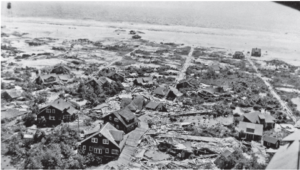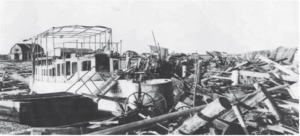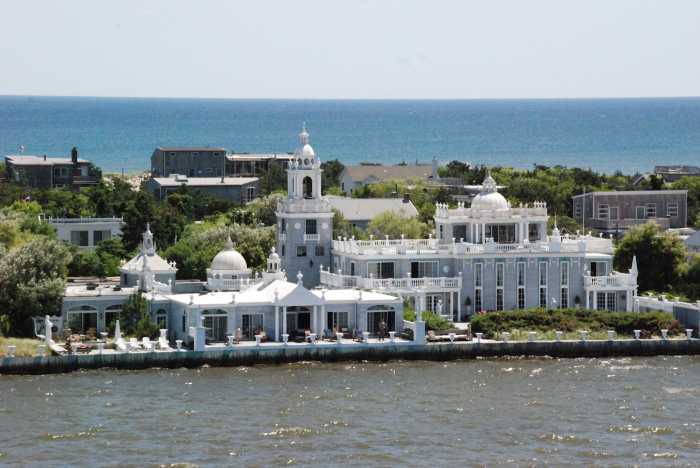Personal Stories from Fire Island
 By Thomas McGannThe hurricane hit Fire Island around 2:30 p.m. The eye was about 50 miles wide, the storm itself about 500 miles across. High tide was even higher than usual because of the autumnal equinox when the sun and moon align with the Earth. Pushed by winds gusting over 180 mph, the sea surge, between 30 and 80 feet high (accounts still vary), pounded the coastline with uncountable tons of seawater.Ocean Beach/The Great South Bay “Let go the anchor!” Captain Patterson bellowed over the howling gale. “Which one?” yelled the mate. “Both of them! This is more than just another Nor’easter!”The ferry “Ocean Beach” left the dock en route to Bay Shore in the teeth of gale force winds, winds growing in intensity minute by minute. It snapped around, suddenly, blowing from the northwest, driving the ferry east. “Let out more scope!” Patterson ordered. “The anchors aren’t holding.” The winds blew a steady 120 knots, gusting higher. The tide, already at its autumnal high, rose 12 to 15 feet in the bay twisting the “Ocean Beach” sideways, anchors dragging, waves pummeling its sides.Meanwhile in Saltaire… In an account Barbara Overton Christie recalled that day: “‘Radio says a storm’s coming up,’ a local man told Mother and I. ‘Better batten down tight.’ Sure enough, right after lunch the rains came. The lights suddenly went out, the radio dead. I opened the front door to check on the ocean just as a huge wave crashed over the dunes and swept in under our cottage. A larger wave followed, roaring past. ‘We’d better get to Town Hall,’ Mother shouted over the din. ‘We don’t want to get marooned.’ Mother stuffed jewelry and some cash in her purse along with her favorite scissors, and we started for the front door. A wall of water slammed over the dunes demolishing the boardwalk. We turned and rushed out the back door as a 25-foot high wave slammed into the cottage, sweeping us along with it, stumbling, water up to our knees. The cottage behind ours exploded into pieces. ‘We need to get inside,’ Mother cried. ‘Anywhere!’ We struggled toward a cottage still standing. The waves were breaking over the top of the houses and we were under them.”The ferry “Eladio” heaved wildly in the boat basin, its lines straining against the whipping winds and churning seas. The eye of the storm was approaching. Word was passed for everyone to retreat to the dock where the boat was waiting. A 30-foot tidal wave breached the dunes. Houses were knocked off their foundations and floated away. Cottage ground against cottage. Boardwalk slats flew through the air. Mrs. Marjorie Hopkins and her three children heard the homes breaking apart as they ran through the rising waters, a giant wave rolling after them. It kept coming. They stumbled aboard the “Eladio” and the ocean swept past.Mary Frances Broadnax, a maid closing her employer’s house for the season, never got the word to retreat to the dock. The house, only a block from the ocean, was suddenly smashed apart by breakers. She climbed up onto the roof through the hole where a chimney had once been just as the roof broke away and floated off. She jumped to a second roof with a stout chimney to cling to.Alice Trottier, her sister, Angeline Bazinet, and an elderly neighbor were up on the second floor playing cards when, without warning, the ocean was in the room with them, the house gone from around them. Alice, struggling to stay afloat, grabbed Angeline, who could not swim, by an arm, wrapping the other around a telephone pole, hanging on for dear life. Their neighbor was gone.
By Thomas McGannThe hurricane hit Fire Island around 2:30 p.m. The eye was about 50 miles wide, the storm itself about 500 miles across. High tide was even higher than usual because of the autumnal equinox when the sun and moon align with the Earth. Pushed by winds gusting over 180 mph, the sea surge, between 30 and 80 feet high (accounts still vary), pounded the coastline with uncountable tons of seawater.Ocean Beach/The Great South Bay “Let go the anchor!” Captain Patterson bellowed over the howling gale. “Which one?” yelled the mate. “Both of them! This is more than just another Nor’easter!”The ferry “Ocean Beach” left the dock en route to Bay Shore in the teeth of gale force winds, winds growing in intensity minute by minute. It snapped around, suddenly, blowing from the northwest, driving the ferry east. “Let out more scope!” Patterson ordered. “The anchors aren’t holding.” The winds blew a steady 120 knots, gusting higher. The tide, already at its autumnal high, rose 12 to 15 feet in the bay twisting the “Ocean Beach” sideways, anchors dragging, waves pummeling its sides.Meanwhile in Saltaire… In an account Barbara Overton Christie recalled that day: “‘Radio says a storm’s coming up,’ a local man told Mother and I. ‘Better batten down tight.’ Sure enough, right after lunch the rains came. The lights suddenly went out, the radio dead. I opened the front door to check on the ocean just as a huge wave crashed over the dunes and swept in under our cottage. A larger wave followed, roaring past. ‘We’d better get to Town Hall,’ Mother shouted over the din. ‘We don’t want to get marooned.’ Mother stuffed jewelry and some cash in her purse along with her favorite scissors, and we started for the front door. A wall of water slammed over the dunes demolishing the boardwalk. We turned and rushed out the back door as a 25-foot high wave slammed into the cottage, sweeping us along with it, stumbling, water up to our knees. The cottage behind ours exploded into pieces. ‘We need to get inside,’ Mother cried. ‘Anywhere!’ We struggled toward a cottage still standing. The waves were breaking over the top of the houses and we were under them.”The ferry “Eladio” heaved wildly in the boat basin, its lines straining against the whipping winds and churning seas. The eye of the storm was approaching. Word was passed for everyone to retreat to the dock where the boat was waiting. A 30-foot tidal wave breached the dunes. Houses were knocked off their foundations and floated away. Cottage ground against cottage. Boardwalk slats flew through the air. Mrs. Marjorie Hopkins and her three children heard the homes breaking apart as they ran through the rising waters, a giant wave rolling after them. It kept coming. They stumbled aboard the “Eladio” and the ocean swept past.Mary Frances Broadnax, a maid closing her employer’s house for the season, never got the word to retreat to the dock. The house, only a block from the ocean, was suddenly smashed apart by breakers. She climbed up onto the roof through the hole where a chimney had once been just as the roof broke away and floated off. She jumped to a second roof with a stout chimney to cling to.Alice Trottier, her sister, Angeline Bazinet, and an elderly neighbor were up on the second floor playing cards when, without warning, the ocean was in the room with them, the house gone from around them. Alice, struggling to stay afloat, grabbed Angeline, who could not swim, by an arm, wrapping the other around a telephone pole, hanging on for dear life. Their neighbor was gone. Back on the Bay Captain Patterson put the helm hard over trying to turn the ferry’s bow into the wind, hoping the anchors might catch, but they kept bouncing along the bottom. The boat broached, driven by 10 to 12 foot waves directly toward the Point O’Woods dock.Saltaire The Robinsons, a man, his wife Nora, and their son Billy, reached the cottage the same time as Mrs. Overton and her daughter. “We beat against the locked door as the seas beat against us,” Christie recalled. “The door crashed open, the windows blew in. The thunder of the waves, the roar of the wind was deafening. Water quickly swamped the first floor chasing us up a rickety ladder, through a trap door, into the pitch black attic, so low our heads bent against the roof beams. The water was still rising and high tide was hours away. We were trapped.”The “Sea Horse,” a converted battleship tender, was docked near the “Eladio” which was already dangerously overloaded. Some passengers were transferring to the “Sea Horse” when a door carried aloft by the winds crashed through the windshield. They quickly positioned planks over the broken window as wreckage – furniture, walls, doors, tree trunks, debris of all kinds – sailed through the air, hurled against the boats. The water in the basin was chock-a-block full of rubble so thick the boats could not maneuver. No one could leave.Fire Island Coast Guard Station Someone called the Coast Guard. They dispatched an icebreaker, “AB25,” but because of the adverse conditions they could not reach the stranded refugees and were forced to anchor 15 miles to the east.Back in Saltaire Mary spotted a larger roof and jumped for it. The roof floated away, Mary clutching desperately to its chimney through the teeming, drenching rains. The roof crashed into a cottage still anchored to its foundation. Mary clambered off the roof, through an attic window into the house. She barricaded the window with furniture and started praying.George Baldwin, affectionately known as “Cappy,” crippled from the waist down, was a tough bird, living alone in his houseboat. That afternoon he was tending his “continuation stew,” a pot to which he regularly added the catch-of-the-day. The locals swore the stew would kill him, but it didn’t. The hurricane didn’t kill him either. A roof gable slammed into his houseboat. Cappy grabbed onto the roof and, like Mary, became another roof-rider. Because of the impairment of his legs, Cappy had developed enormous upper body strength. He clung to the slick roof for five tortuous hours.Mrs. Overton’s pocketbook, full of jewels, some cash, and her favorite scissors, dropped through the trap door into the swirling waters below. The water level was still rising. We were to be drowned like unwanted kittens in the dark void of that black, claustrophobic attic.Oakleyville/Point O’Woods The “Ocean Beach” ran down on the Point O’Woods dock pushed along by the violent wind-driven waves and hurricane winds. The dock, some 10 feet wide supported by wooden pilings, jutted out into bay directly in the path of the unchecked ferry. Its anchors, bouncing off the bottom of the bay, had little effect on the heaving vessel. It rammed broadside into the dock, heeling violently. The momentum of the “Ocean Beach” drove it through the dock, destroying it, pushing the vessel up onto a sand bar off Oakleyville, aground.Cherry Grove Other ferries were also in action. Captain William Ryan rescued about 30 people from Cherry Grove and ferried them to Sayville in a harrowing two-hour trip with a compass he could not read because of the violent action of the boat and a windshield through which he could not see because of heavy salt spray.The “Edward,” the boat Captain Warner used to deliver produce to the beach, picked up castaways at Cherry Grove also. However, it developed engine trouble and was driven eastward into Long Cove where it barely weathered the storm. Housemovers were needed to refloat the “Edward.”Saltaire Again Little Billy cried, ‘Mommy … where’s my kitten?’ ‘Shush,’ his Mommy whispered. ‘She’ll be alright.’ His mother sang to him, later confiding to me that when the final crash came, she would hold his head under water so that he might drown quickly rather than being killed by the tempest. I looked down through the trap door, past our hanging feet, ‘The water’s stopped rising!’‘Where are we?’ someone asked. We were looking at the Great South Bay. The house in which we had found shelter was no longer near the ocean. It had sailed, with us in it, all the way across the island and become impaled on a telephone pole that kept us from being tossed into the frenzied waters of the bay.The Robinson and Overton families staggered outside. The tide was down and the wind was abating. We broke into a lopsided cottage. Waves swept over its porch, but it was safer than our previous dwelling. Three inches of wet sand covered the first floor, but on the second we found dry clothes. Some wayward oranges provided a welcome feast. We cried and laughed and sang in joyous relief. The stars were out.The survivors, huddling aboard the “Eladio” and the “Sea Horse,” cheered the arrival of “AB25” with its food and hot coffee. After a brief repast, they set out for Village Hall finding dry shelter on its second floor. Groups of men set out on rescue missions – if there was anyone to rescue.Mary kept vigil from her furniture-barricaded perch in the attic. Her prayers were answered that evening when she was rescued by one of the searchers, Mike Coffey.Alice’s sister was torn from her arms and swept away. Alice hung onto the telephone pole until the wind moderated. She climbed down and crawled into the relative safety of a small roofless building. Mike Coffey found her too, and arm around her waist, forced them through a half mile of detritus filled water, back to the dock, where they both collapsed from exhaustion.At dawn the five of us left our latest quarters, waded through waist-high water across a new inlet carved by the sea, and stumbled into Town Hall where we were greeted by 70 other survivors provisioning there.Oakleyville The crew and passengers aboard the “Ocean Beach” rode out the storm fast aground on the sand bar. As the storm passed, the ebbing waters rushed out of the bay leaving the boat heeled over so far that the fire extinguishers self-activated. But everyone was safe.Saltaire Mrs. Overton’s pocketbook, which had dropped into the water as she scrambled up into the attic that afternoon, was found floating in the Great South Bay. Sodden and misshapen, it was returned to her anonymously in the mail. Still inside were her driver’s license, some coins, her favorite scissors – and a piece of jade a friend had given her years before – for good luck.Kismet A school had opened in Kismet in 1938. It sported a steeple with a bell that tolled mournfully as the hurricane swept it away. The school was never rebuilt.The Aftermath… Four Fire Islanders were killed – all in Saltaire.The day after the storm, Thursday, Sept. 22, was a perfect day. The sea’s rage had tempered. The sun was warm, the water calm, and the weather remained glorious for the rest of September. After a hurricane there is a holy silence, like God has taken a deep breath and held it. “Even the birds seemed disoriented,” one man said. “They come out – what birds were left – but they seemed spooky. They were as still as could be. They didn’t sing or anything.” Another man remembered, “Everything was beautifully clean after that. The next day and the next few weeks you never saw the air so clean. At night you could see stars you never could see before.”A special thanks to Jim O’Hare for his help with attributions in compiling this article. – T.M.
Back on the Bay Captain Patterson put the helm hard over trying to turn the ferry’s bow into the wind, hoping the anchors might catch, but they kept bouncing along the bottom. The boat broached, driven by 10 to 12 foot waves directly toward the Point O’Woods dock.Saltaire The Robinsons, a man, his wife Nora, and their son Billy, reached the cottage the same time as Mrs. Overton and her daughter. “We beat against the locked door as the seas beat against us,” Christie recalled. “The door crashed open, the windows blew in. The thunder of the waves, the roar of the wind was deafening. Water quickly swamped the first floor chasing us up a rickety ladder, through a trap door, into the pitch black attic, so low our heads bent against the roof beams. The water was still rising and high tide was hours away. We were trapped.”The “Sea Horse,” a converted battleship tender, was docked near the “Eladio” which was already dangerously overloaded. Some passengers were transferring to the “Sea Horse” when a door carried aloft by the winds crashed through the windshield. They quickly positioned planks over the broken window as wreckage – furniture, walls, doors, tree trunks, debris of all kinds – sailed through the air, hurled against the boats. The water in the basin was chock-a-block full of rubble so thick the boats could not maneuver. No one could leave.Fire Island Coast Guard Station Someone called the Coast Guard. They dispatched an icebreaker, “AB25,” but because of the adverse conditions they could not reach the stranded refugees and were forced to anchor 15 miles to the east.Back in Saltaire Mary spotted a larger roof and jumped for it. The roof floated away, Mary clutching desperately to its chimney through the teeming, drenching rains. The roof crashed into a cottage still anchored to its foundation. Mary clambered off the roof, through an attic window into the house. She barricaded the window with furniture and started praying.George Baldwin, affectionately known as “Cappy,” crippled from the waist down, was a tough bird, living alone in his houseboat. That afternoon he was tending his “continuation stew,” a pot to which he regularly added the catch-of-the-day. The locals swore the stew would kill him, but it didn’t. The hurricane didn’t kill him either. A roof gable slammed into his houseboat. Cappy grabbed onto the roof and, like Mary, became another roof-rider. Because of the impairment of his legs, Cappy had developed enormous upper body strength. He clung to the slick roof for five tortuous hours.Mrs. Overton’s pocketbook, full of jewels, some cash, and her favorite scissors, dropped through the trap door into the swirling waters below. The water level was still rising. We were to be drowned like unwanted kittens in the dark void of that black, claustrophobic attic.Oakleyville/Point O’Woods The “Ocean Beach” ran down on the Point O’Woods dock pushed along by the violent wind-driven waves and hurricane winds. The dock, some 10 feet wide supported by wooden pilings, jutted out into bay directly in the path of the unchecked ferry. Its anchors, bouncing off the bottom of the bay, had little effect on the heaving vessel. It rammed broadside into the dock, heeling violently. The momentum of the “Ocean Beach” drove it through the dock, destroying it, pushing the vessel up onto a sand bar off Oakleyville, aground.Cherry Grove Other ferries were also in action. Captain William Ryan rescued about 30 people from Cherry Grove and ferried them to Sayville in a harrowing two-hour trip with a compass he could not read because of the violent action of the boat and a windshield through which he could not see because of heavy salt spray.The “Edward,” the boat Captain Warner used to deliver produce to the beach, picked up castaways at Cherry Grove also. However, it developed engine trouble and was driven eastward into Long Cove where it barely weathered the storm. Housemovers were needed to refloat the “Edward.”Saltaire Again Little Billy cried, ‘Mommy … where’s my kitten?’ ‘Shush,’ his Mommy whispered. ‘She’ll be alright.’ His mother sang to him, later confiding to me that when the final crash came, she would hold his head under water so that he might drown quickly rather than being killed by the tempest. I looked down through the trap door, past our hanging feet, ‘The water’s stopped rising!’‘Where are we?’ someone asked. We were looking at the Great South Bay. The house in which we had found shelter was no longer near the ocean. It had sailed, with us in it, all the way across the island and become impaled on a telephone pole that kept us from being tossed into the frenzied waters of the bay.The Robinson and Overton families staggered outside. The tide was down and the wind was abating. We broke into a lopsided cottage. Waves swept over its porch, but it was safer than our previous dwelling. Three inches of wet sand covered the first floor, but on the second we found dry clothes. Some wayward oranges provided a welcome feast. We cried and laughed and sang in joyous relief. The stars were out.The survivors, huddling aboard the “Eladio” and the “Sea Horse,” cheered the arrival of “AB25” with its food and hot coffee. After a brief repast, they set out for Village Hall finding dry shelter on its second floor. Groups of men set out on rescue missions – if there was anyone to rescue.Mary kept vigil from her furniture-barricaded perch in the attic. Her prayers were answered that evening when she was rescued by one of the searchers, Mike Coffey.Alice’s sister was torn from her arms and swept away. Alice hung onto the telephone pole until the wind moderated. She climbed down and crawled into the relative safety of a small roofless building. Mike Coffey found her too, and arm around her waist, forced them through a half mile of detritus filled water, back to the dock, where they both collapsed from exhaustion.At dawn the five of us left our latest quarters, waded through waist-high water across a new inlet carved by the sea, and stumbled into Town Hall where we were greeted by 70 other survivors provisioning there.Oakleyville The crew and passengers aboard the “Ocean Beach” rode out the storm fast aground on the sand bar. As the storm passed, the ebbing waters rushed out of the bay leaving the boat heeled over so far that the fire extinguishers self-activated. But everyone was safe.Saltaire Mrs. Overton’s pocketbook, which had dropped into the water as she scrambled up into the attic that afternoon, was found floating in the Great South Bay. Sodden and misshapen, it was returned to her anonymously in the mail. Still inside were her driver’s license, some coins, her favorite scissors – and a piece of jade a friend had given her years before – for good luck.Kismet A school had opened in Kismet in 1938. It sported a steeple with a bell that tolled mournfully as the hurricane swept it away. The school was never rebuilt.The Aftermath… Four Fire Islanders were killed – all in Saltaire.The day after the storm, Thursday, Sept. 22, was a perfect day. The sea’s rage had tempered. The sun was warm, the water calm, and the weather remained glorious for the rest of September. After a hurricane there is a holy silence, like God has taken a deep breath and held it. “Even the birds seemed disoriented,” one man said. “They come out – what birds were left – but they seemed spooky. They were as still as could be. They didn’t sing or anything.” Another man remembered, “Everything was beautifully clean after that. The next day and the next few weeks you never saw the air so clean. At night you could see stars you never could see before.”A special thanks to Jim O’Hare for his help with attributions in compiling this article. – T.M.




























